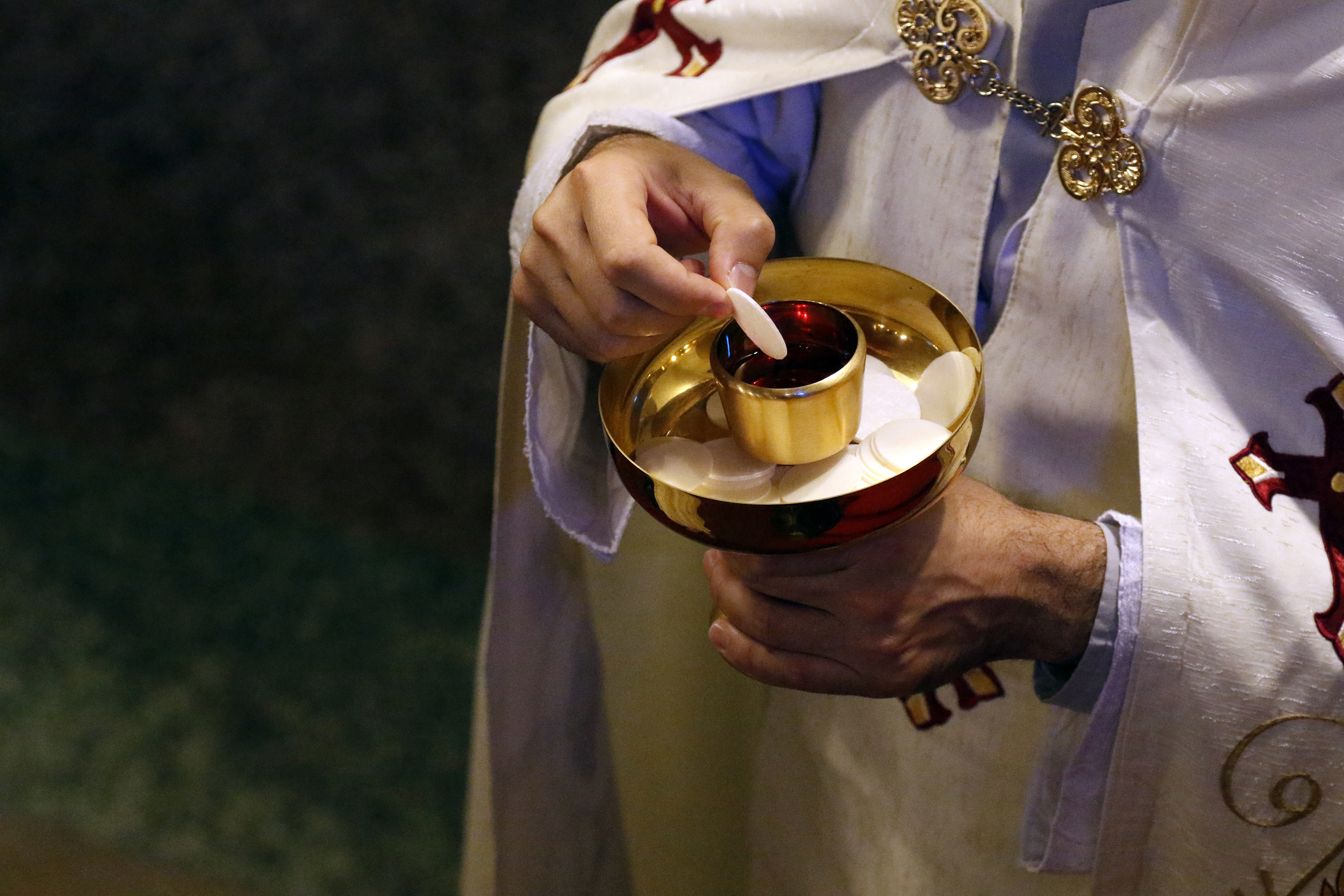
A priest prepares to distribute Communion during a Divine Liturgy at Our Lady of Lebanon Maronite Cathedral in Brooklyn, N.Y. The practice of intinction, or dipping the consecrated bread into the consecrated wine, is common in Eastern-rite communities of the Roman Catholic Church. (CNS photo/Gregory A. Shemitz)
Flu, pneumonia and viral cold season is upon us. Is sipping from the communion cup a hazard to your health? Certainly, it is risky.
One medical doctor colleague who served as a minister of the cup told us of his experience after all the people had communicated. He consumed the remaining Precious Blood. Not long afterward he came down with mononucleosis. He could think of no other reason for contracting mono than his experience of drinking the remains of the cup. Whether our friend's analysis is correct or not, it discouraged him from being a communion minister and drinking from the cup.
A church organist told us she stopped receiving the Blood of Christ years ago when she found she was frequently getting sick with upper respiratory infections. One of our communion ministers of the cup recounted that at the end of communion when she looked into the cup with particles floating around and remembering all the people who have sipped, it turned her stomach. She would no longer serve as a communion minister because she said "what should be uplifting is gross."
Why do more than 50 percent of Catholics after receiving the consecrated host hesitate to drink from the same cup at liturgy? Health! Most medical people would advise against the congregation drinking from the same cup.
Some people suggest that the alcohol in the wine protects the drinker. Unfortunately, the low alcohol content of the wine is not antiseptic. A swab from the cup and onto a nutrient petri dish would prove the point to the most devout communicant.
In the United States it is not our custom to share cups, utensils or straws. Consider the reaction of guests if you were the host of a party, put only one large cup of wine on the table and told the guests that they should pass this cup of wine around and share. A congregation drinking from the same cup is a time bomb waiting to happen.
There is a practical solution for receiving the Precious Blood already approved by the American bishops. The United States Bishop's Conference in 2017 issued Norms for the Distribution and Reception of Holy Communion. Norms presents another form for distributing the Precious Blood. It is intinction.
Intinction means that the consecrated bread is placed in or dipped into the consecrated wine; people then receive in one eating action the Body and Blood of Christ.
As a medical doctor for over 27 years and in family practice, I never drink from the cup unless I am the first after the priest. Most parishioners are quite capable of casual exposure to bacteria or virus particles. But the elderly, the frail or those otherwise immunocompromised are at much greater risk of severe illness when drinking from a common cup. Today, the elderly often make up a large portion of the congregation.
Additionally, infected parishioners fail to understand when they are contagious. We have watched people who are coughing violently after a week of moderately severe influenza and then take from the cup first in the communion line. Despite warnings from the liturgical office of our diocese, they do not recall or advert to the harm of those who follow or the last person who consumes the remains.
Potentially the most infection risk to parishioners is the most insidious. Most viral infections have an incubation period after inoculation and before they feel symptoms. The person does not feel ill. These people shed infectious material several days before the symptoms illness and thus drink unaware that they may be spreading infection.
There are also significant inconsistencies between teaching and practice with our children. Teachers instruct children not to drink from the same cup, drink from other's milk, or share straws. Then at liturgy we go with an opposite message — share the one cup. What a contradiction!
Intinction is another way of distribution. It has many positive factors. Intinction removes entirely the health risks of multiple people drinking from the same cup. It doubles the number of persons receiving both Body and Blood of the Lord. Good results!
During Advent 2017, the Parish of St. Joseph in Randolph, Ohio, practiced intinction and 95 percent of the people received the Body and Blood of Christ. As the administrator of this parish and a priest for 55 years, I can attest there were no drippings and no accidents. The congregation approved of this adult and healthy way of receiving the Eucharist and spoke eloquently with their feet
We handled intinction in the following way. We obtained intinction sets that were used in the Maronite Catholic Rite. The dish in the middle is very shallow and, in this cup, we poured some very red wine for consecration.
At Communion the consecrated host was dipped into the wine by the communion minister but only allowing a small ring of the Precious Blood to form as a crescent on the bottom of the host. The intincted host was then presented to the communicant with the words, "The Body and Blood of Christ." They received the intincted host at the top by their fingers and placed it themselves in their mouth.
Advertisement
An even simpler way would have the communicants themselves dip the host into the shallow cup after the minister offered the cup with the words, "The Blood of Christ." According to the Norms document, this is not self-communication since both Body and Blood are presented (offered) to the communicant. This manner of communicating is adult, reverent and healthy.
Intinction almost entirely eliminates the health issue. Bishop George Murry of the Diocese of Youngstown, remarked to one of us that at times when he places a host on the tongue, the person closes their mouth on his fingers. Intinction avoids this since the communicant places the host in their own mouth, a very adult way.
If a person has an alcohol reservation, that person would not proceed to the cup. Our experiment indicated that the number of people receiving both Body and Blood of Christ rose from less than 50 percent to at least 95 percent. So many more received the "fuller sign" in accordance with the church's wishes. This added to the people's religious faith, participation and devotion.
Some church men object, perhaps many of them liturgists, calling this self-intinction. There is no such word self-intinction in the bishops' document. We avoided the problem of self-communication because there was always a minister saying the Body of Christ or The Blood of Christ. We also used intinction positively for First Communion.
Finally, in these troubling times there is a great need for some positive moves from the American bishops that touch all the people. Intinction does this visually, practically and religiously.
The Eucharist is the soul of Catholic practice, the sacrament of sacraments. Actively fostering intinction would show that the bishops are concerned about the health of their people. The American bishops need a positive sign to regain confidence today. Intinction is already in their quiver.
[Jesuit Fr. Thomas S. Acker, Ph.D., is the administrator St. Joseph Parish, in Randolph, Ohio. He is president emeritus of Wheeling Jesuit University. He received his Ph.D. in biology from Stanford University and has taught microbiology and parasitology. He has been an ordained priest for 55 years. Brian Cain, M.D., has spent 27 years in family practice and is an active parishioner of St. Joseph Parish. He is married to a practicing nurse and is the father of three children. He received his M.D. from Northeast Ohio Medical University.]




